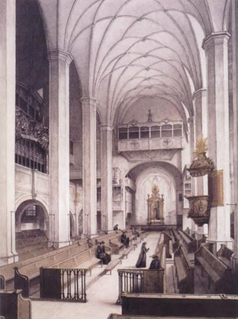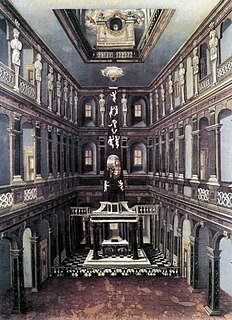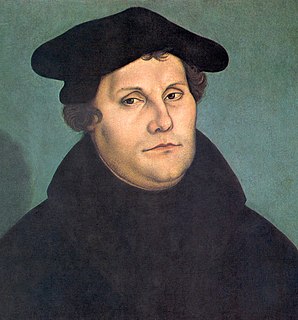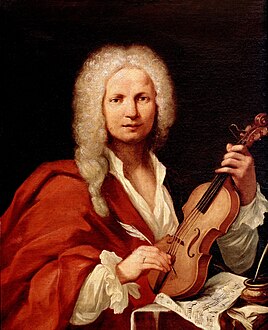
Johann Sebastian Bach composed the church cantata Gott soll allein mein Herze haben, BWV 169, a solo cantata for an alto soloist, in Leipzig for the 18th Sunday after Trinity, and first performed it on 20 October 1726.

Ach Gott, vom Himmel sieh darein, BWV 2 is a chorale cantata composed by Johann Sebastian Bach for the second Sunday after Trinity in 1724. First performed on 18 June in Leipzig, it is the second cantata of his chorale cantata cycle. The church cantata is based on Martin Luther's 1524 hymn "Ach Gott, vom Himmel sieh darein", a paraphrase of Psalm 12.
Nulla in mundo pax sincera, RV 630, is a sacred motet composed by Antonio Vivaldi in 1735 to an anonymous Latin text, the title of which may be translated as "In this world there is no honest peace" or "There is no true peace in this world without bitterness". Written in the key of E major and in the typical lyrical Italian Baroque style, it is scored for solo soprano, two violins, viola and basso continuo, this would normally be a cello and keyboard instrument, in Vivaldi's case often the organ. The text dwells on the imperfections of a world full of evil and sin, and praises Jesus for the salvation he offers from it. It is considered to be one of Vivaldi's most beautiful solo motets.

Herr Gott, dich loben wir, BWV 16, is a church cantata by Johann Sebastian Bach. He composed it in Leipzig for New Year's Day and first performed it on 1 January 1726 as part of his third cantata cycle. The beginning of the text is based on "Herr Gott, dich loben wir", Luther's German Te Deum,

Johann Sebastian Bach composed the church cantata Ich hatte viel Bekümmernis, BWV 21 in Weimar, possibly in 1713, partly even earlier. He used it in 1714 and later for the third Sunday after Trinity of the liturgical year. The work marks a transition between motet style on biblical and hymn text to operatic recitatives and arias on contemporary poetry. Bach catalogued the work as e per ogni tempo, indicating that due to its general theme, the cantata is suited for any occasion.
Gottlob! nun geht das Jahr zu Ende, BWV 28, is a church cantata by Johann Sebastian Bach for the Sunday after Christmas. He first performed it on 30 December 1725.

Aus tiefer Not schrei ich zu dir, BWV 38, is a church cantata by Johann Sebastian Bach. He composed the chorale cantata in Leipzig in 1724 for the 21st Sunday after Trinity and first performed it on 29 October 1724.

Johann Sebastian Bach composed the church cantata Nun komm, der Heiden Heiland, BWV 62, in Leipzig for the first Sunday in Advent and first performed it on 3 December 1724. The chorale cantata is based on Martin Luther's Advent hymn "Nun komm, der Heiden Heiland". It is part of his chorale cantata cycle.

Gott, wie dein Name, so ist auch dein Ruhm, BWV 171, is a church cantata by Johann Sebastian Bach. He composed it in Leipzig for New Year's Day and probably first performed it on 1 January 1729.

Ärgre dich, o Seele, nicht, BWV 186 is a church cantata by Johann Sebastian Bach. He composed it originally in Weimar in 1716 for Advent, BWV 186a, and expanded it in Leipzig in 1723 for the seventh Sunday after Trinity, where he first performed it on 11 July 1723.

Johann Sebastian Bach composed the church cantata Warum betrübst du dich, mein Herz, BWV 138, in Leipzig for the 15th Sunday after Trinity and first performed it on 5 September 1723. The text by an unknown author includes three stanzas from the hymn of the same name. Its text and melody were formerly attributed to Hans Sachs, but were written by an unknown hymn writer. The cantata has seven movements and is scored for SATB soloists and choir, two oboes d'amore, two violins, viola and basso continuo. The cantata has features of a chorale cantata although it was written a year before Bach's annual cycle of chorale cantatas. Bach used an aria as the base of the Gratias of his Missa in G major.

Johann Sebastian Bach composed the church cantata Ich armer Mensch, ich Sündenknecht, BWV 55, in Leipzig for the 22nd Sunday after Trinity and first performed it on 17 November 1726.

Wachet! betet! betet! wachet! is the title of two church cantatas by Johann Sebastian Bach. He composed a first version, BWV 70a, in Weimar for the second Sunday in Advent of 1716 and expanded it in 1723 in Leipzig to BWV 70, a cantata in two parts for the 26th Sunday after Trinity.

Mein liebster Jesus ist verloren, BWV 154, is a church cantata by Johann Sebastian Bach. He composed it for the first Sunday after Epiphany and first performed it in Leipzig on 9 January 1724.

Johann Sebastian Bach composed the church cantata Ach Herr, mich armen Sünder, BWV 135 in Leipzig for the third Sunday after Trinity and first performed it on 25 June 1724. It is the fourth chorale cantata from his second annual cycle, and is based on the hymn by Cyriakus Schneegass.

Christum wir sollen loben schon, BWV 121, is a church cantata by Johann Sebastian Bach. He composed this Christmas cantata in Leipzig in 1724 for the second day of Christmas and first performed it on 26 December 1724. The chorale cantata is based on the hymn by Martin Luther "Christum wir sollen loben schon".

Johann Sebastian Bach composed the church cantata Nimm von uns, Herr, du treuer Gott, BWV 101 in Leipzig for the tenth Sunday after Trinity and first performed it on 13 August 1724. The chorale cantata is based on the hymn by Martin Moller (1584).










